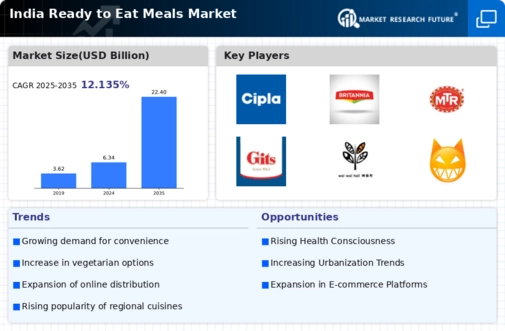Rising Disposable Incomes
India's economic growth has led to a rise in disposable incomes, which is influencing consumer spending patterns. As more households experience increased financial flexibility, there is a noticeable shift towards premium food products, including ready to-eat meals. The ready to-eat-meals market is benefiting from this trend, as consumers are willing to pay a premium for quality and convenience. Reports indicate that the middle-class population is expected to grow by 12% annually, further expanding the market for ready to-eat meals. This demographic is increasingly prioritizing convenience and quality, which positions the ready to-eat-meals market favorably for sustained growth in the coming years.
Changing Dietary Preferences
The evolving dietary preferences among Indian consumers are significantly impacting the ready to-eat-meals market. With a growing awareness of health and wellness, there is an increasing demand for meals that cater to specific dietary needs, such as vegetarian, vegan, and gluten-free options. This shift is prompting manufacturers to innovate and diversify their product offerings to meet these preferences. Data suggests that the vegetarian segment alone constitutes over 30% of the ready to-eat-meals market, reflecting the cultural inclination towards plant-based diets. As consumers become more health-conscious, the ready to-eat-meals market is likely to adapt by introducing healthier options that align with these changing dietary trends.
Increased Focus on Sustainability
Sustainability is becoming a pivotal concern for consumers in India, influencing their purchasing decisions in the ready to-eat-meals market. As awareness of environmental issues grows, consumers are increasingly favoring brands that prioritize sustainable practices, such as eco-friendly packaging and ethically sourced ingredients. This trend is prompting manufacturers to adopt more sustainable practices in their production processes. Reports indicate that nearly 40% of consumers are willing to pay more for products that are environmentally friendly. Consequently, the ready to-eat-meals market is likely to see a rise in demand for products that not only offer convenience but also align with consumers' values regarding sustainability.
Urbanization and Lifestyle Changes
The rapid urbanization in India is reshaping consumer lifestyles, leading to an increased demand for convenience in food options. As more individuals migrate to urban areas, the need for quick and easy meal solutions becomes paramount. The ready to-eat-meals market is experiencing growth as busy professionals and students seek nutritious and time-saving alternatives. According to recent data, urban areas account for approximately 35% of India's population, and this demographic shift is expected to drive the ready to-eat-meals market further. The convenience factor, coupled with the increasing number of working women, is likely to propel the demand for ready to-eat meals, as they offer a practical solution for those with limited time for cooking.
Technological Advancements in Food Processing
Technological innovations in food processing are playing a crucial role in enhancing the quality and shelf-life of ready to-eat meals. Advances in packaging technology, such as vacuum sealing and modified atmosphere packaging, are enabling manufacturers to preserve the freshness and nutritional value of meals for extended periods. This is particularly relevant in the ready to-eat-meals market, where consumers seek products that are not only convenient but also safe and nutritious. The introduction of smart packaging solutions is also gaining traction, allowing for better inventory management and reduced food waste. As these technologies continue to evolve, they are likely to further bolster the ready to-eat-meals market by meeting consumer demands for quality and convenience.



















Leave a Comment